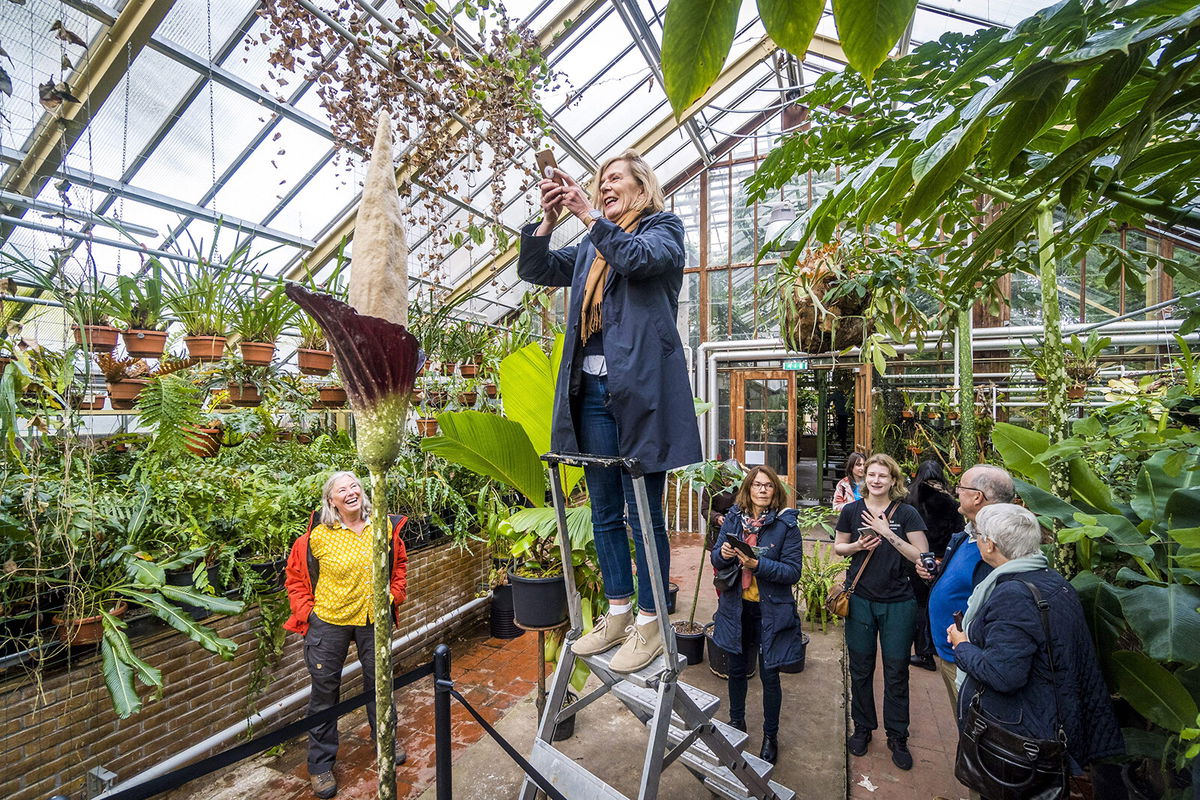The rare ‘penis plant’ just bloomed for the first time in over two decades

A woman takes pictures of the flowering "penis plant" in the tropical greenhouses of the Leiden Hortus Botanicus on October 22.
By Kristen Rogers, CNN
In a Netherlands garden blooms a rare plant with a tall, phallic shape. It’s known as the “penis plant,” and this is only the third time the species has flowered in Europe since 1997, according to the University of Leiden’s botanical garden, Leiden Hortus Botanicus.
The six-year-old penis plant — the scientific name for which is Amorphophallus decus-silvae — was cultivated by garden volunteer Rudmer Postma, according to a news release. Garden personnel first noticed the flower bud in mid-September, and in just over a month, the bud has become about half a meter (over 3 feet) tall, with the narrow stem reaching up to 2 meters (over 6 feet) high.
“Few botanical gardens have Amorphophallus decus-silvae in their collection, making the flowering of the plant particularly rare,” the release noted.
Native to tropical rainforest-rich Indonesia, the penis plant requires a very warm and humid growing environment and is therefore difficult to grow in Europe. But its terrible, pungent odor — akin to rotting flesh — helps gardeners predict when the plant will flower, which according to the release, happens in two stages: the female bloom phase and the male bloom phase.
During the female bloom phase, the white, phallus-shaped part of the flower called the spadix heats up and emits the stench.
“It didn’t smell very bad yet, but (the odor) got more intense in the afternoon,” said garden volunteer and yoga teacher Roos Kocken in a TikTok video she posted October 22.
Pollinators, including flies, are attracted to this smell, so they flock to the plant and become covered in pollen the plant produces during its male bloom phase. Since there isn’t another penis plant at the Leiden Hortus Botanicus, staffers are collecting the pollen to use later or send to other botanical gardens, the university said.
For larger Amorphophallus plants, to have many years between blooms isn’t unusual, said Susan Pell, the deputy executive director of the US Botanical Garden.
Amorphophallus plants’ blooms emerge from their underground structures called corms, which are like the underground part of tree trunks, she explained.
“That bloom is just using up all of the energy that’s been stored in that corm. And so in order to bloom again, that corm has to produce a series of leaves over … somewhere between probably three and 10 or 12 years in order to get enough energy built back up in the corm to support a bloom, which really occupies that corm for more than a year,” Pell added.
The plant’s close relatives include Amorphophallus gigas and Amorphophallus titanum, or the corpse plant, the latter of which is well-known for its own stench during the flowering period. The corpse flower has been displayed at popular gardens including the Leiden Hortus Botanicus, the United States Botanic Garden and the San Diego Botanic Garden.
The-CNN-Wire
™ & © 2021 Cable News Network, Inc., a WarnerMedia Company. All rights reserved.